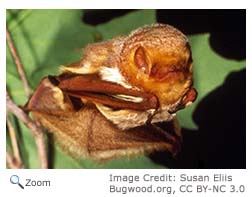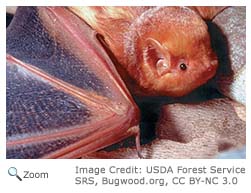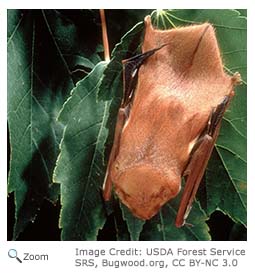Characteristics  The eastern red bat is a tree bat. It is 3½ to 4½ inches in length with a wingspan of about 13 inches. It has small, rounded ears and long and silky fur that can be red to a golden brown. It has white shoulder patches and its fur has a white tip that gives it a frosted look.
Males are redder in color than females. The eastern red bat is a tree bat. It is 3½ to 4½ inches in length with a wingspan of about 13 inches. It has small, rounded ears and long and silky fur that can be red to a golden brown. It has white shoulder patches and its fur has a white tip that gives it a frosted look.
Males are redder in color than females.
Range
The eastern red bat can be found from from southern Canada south through most of the the United States and down to Chile and Argentina.
Habitat
The eastern red bat lives in forests, forest edges and hedgerows. It roosts among foliage, usually in
deciduous trees, but it will sometimes roost in coniferous trees. The eastern red bats coloration helps them blend in with the foliage! When the hang upside down, they look like dead leaves or pine cones!
|
|
Diet
The eastern red bat hunts for food at night. It is a very fast flyer and often follows the same path every night! It eats beetles, moths, ants, leafhoppers, planthoppers, flies and other insects. It can be seen feeding in the early evening hours in warm months at forest and woodland edges, clearings and around street lights.
Life Cycle
 The eastern red bat mates in the fall. The female red bat is the only bat with four teats. Most bats have only a single baby, but The eastern red bat gives birth to 2-4 babies in early summer. Newborn bats are born hairless. They will hang onto their mother with one foot and hang onto a perch with the other foot! At night, the mother will leave her young to feed. They will fly when they are about three to five weeks old and are weaned a few weeks later. The eastern red bat mates in the fall. The female red bat is the only bat with four teats. Most bats have only a single baby, but The eastern red bat gives birth to 2-4 babies in early summer. Newborn bats are born hairless. They will hang onto their mother with one foot and hang onto a perch with the other foot! At night, the mother will leave her young to feed. They will fly when they are about three to five weeks old and are weaned a few weeks later.
Behavior
 The eastern red bat is a solitary bat excepts during mating and migration. During the day, it hangs 4 to 10 feet above the ground among dense foliage. The eastern red bat migrates in flocks to the southern part of its range in the winter. It hibernates during the cold winter months. On warm days, it may emerge from hibernation to feed! The eastern red bat is a solitary bat excepts during mating and migration. During the day, it hangs 4 to 10 feet above the ground among dense foliage. The eastern red bat migrates in flocks to the southern part of its range in the winter. It hibernates during the cold winter months. On warm days, it may emerge from hibernation to feed!
|